Table of Contents
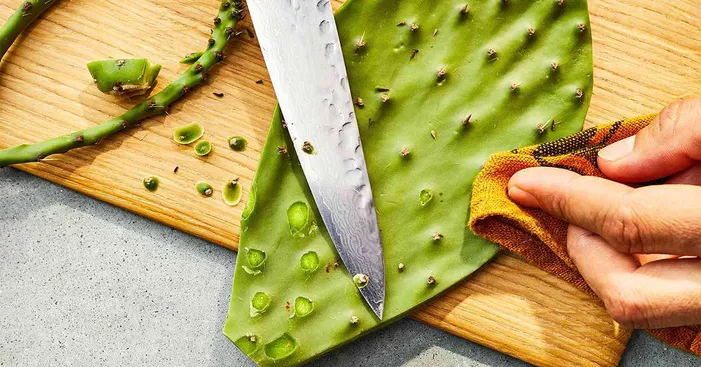
Nopales aren’t exactly the cuddliest vegetables on the block.
Those spiky paddles scream “Stay away!” louder than a grumpy hedgehog.
But don’t let their prickly armor fool you!
Beneath those needles lies a heart of nutritional gold, bursting with vitamins, antioxidants, and fiber that would make even the most ardent kale enthusiast do a double take.
So, grab your tongs, channel your inner cactus whisperer, and prepare to unlock the secrets of this surprisingly delicious (and health-boosting) desert warrior!
General facts about nopales:
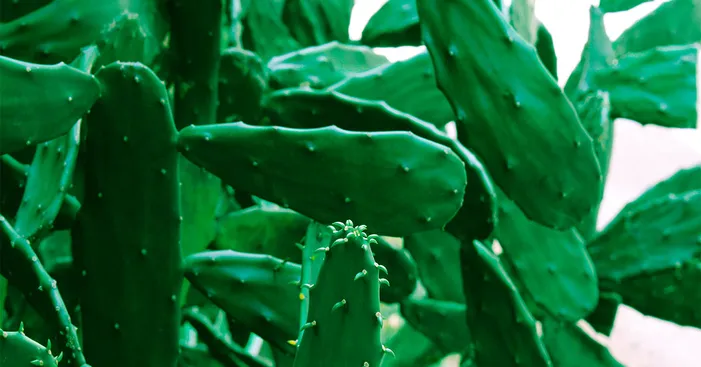
Overview:
Meet the nopales cactus, a prickly wonder from the Cactaceae family, thriving in the sun-baked embrace of American deserts.
This tenacious survivor, also known as the prickly pear, offers a treasure trove of uses that have captivated people for centuries.
Its crowning glory? Flat, segmented pads called cladodes, studded with tiny needles known as glochids.
These spiky shields not only offer protection but are also the star ingredient in countless culinary delights and traditional remedies.
Depending on the variety and climate, nopales can climb from humble inches to towering meters, a testament to their adaptability.
Born in the arid embrace of Central and North America, nopales grace landscapes from Mexico to the southwestern United States and beyond.
Their scientific name, Opuntia, whispers of their distant Greek roots, while “prickly pear” echoes their journey across the sea, brought by the Moors who recognized their agricultural potential.
History of nopales:
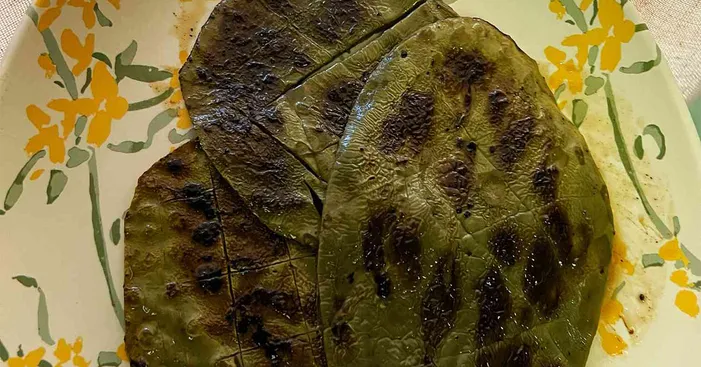
More than just a spiky desert dweller, the nopales cactus, known in Mexico as “nopales,” has thrived as a symbol and lifeblood for centuries.
Native to Mexico, this tenacious Opuntia ficus-indica ventured beyond its borders, blossoming across Central and South America under the moniker “prickly pear.”
Its journey continues even today, puncturing landscapes from the Mediterranean to Asia.
But Nopales’s story isn’t solely one of geographical conquest.
In Mexico, it’s deeply woven into the fabric of history and culture.
It proudly sits at the heart of the national flag, where an eagle clutches a serpent atop its emerald pads.
Legend claims this vision guided the Aztecs to found their magnificent Tenochtitlan, now Mexico City.
Beyond symbolic grandeur, nopales offered practical blessings.
Vast plantations provided a vibrant crimson dye, courtesy of tiny cochineal insects that called the cactus home.
This precious pigment clothed royalty and painted history.
But Nopales’s bounty also nourished its people.
Aztec and Mayan ingenuity unlocked its culinary and medicinal secrets.
These broad, snowshoe-like pads adorned tables as salads and stews, while their prickly juice soothed burns and soothed ailments.
Nopales became a pantry staple and a trusted healer, whispering ancient wisdom in every bite and poultice.
Over time, whispers turned to roars as the world discovered Nopales’s hidden powers.
Its leaves, long revered for easing digestion and soothing skin, now captivate science with their potential to combat diabetes and shed unwanted pounds.
Nopales nutritional values and health benefits:
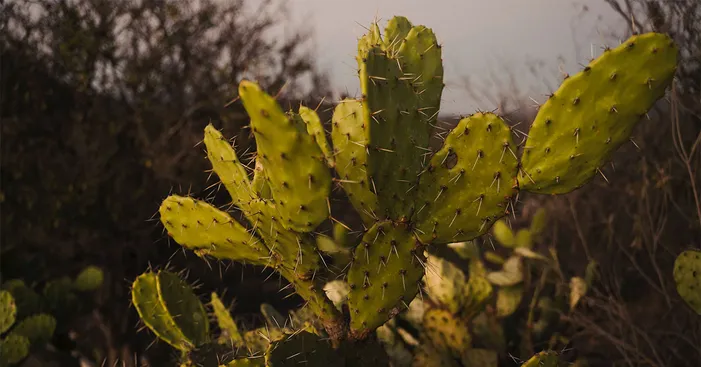
Nutritional values:
Weighing in at a mere 24 calories per 150-gram serving, the nopales cactus is a champion of lightweights in the fruit world.
With fat content barely registering at 0.135 grams, it’s practically fat-free, boasting just a tiny whisper of monounsaturated and saturated fats (0.027 and 0.024 grams, respectively).
But don’t mistake its featherweight status for lack of substance.
Nopales packs a surprising 4.98 grams of carbohydrates, including a generous 3.3 grams of gut-friendly fiber and 1.72 grams of natural sugars.
It even throws in nearly 2 grams of protein for good measure.
Beyond these basic building blocks, nopales offers a treasure trove of essential nutrients:
- Vitamine C: 11,8 mg
- Calcium: 246 mg
- Potassium: 384 mg
- Magnesium: 78 mg
- Phosphore: 24 mg
Health benefits:
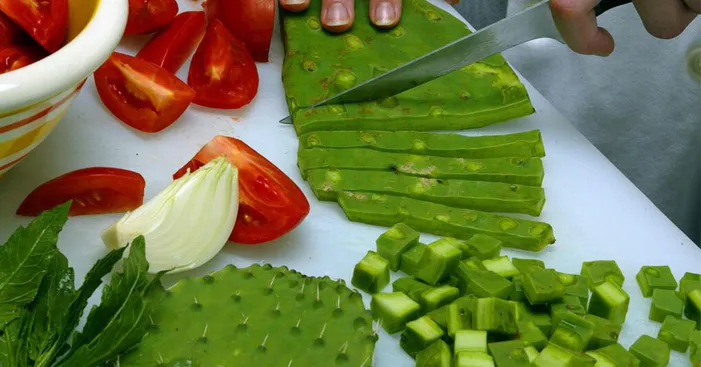
Hailing from Mexico, the nopales cactus has transcended borders with its remarkable qualities.
Used for millennia by ancient peoples for its medicinal virtues, it’s now captivating the health and wellness scene.
Let’s delve into the treasure trove of benefits nopales offers our bodies.
Whether you’re aiming to bolster your defenses or embark on a weight-conscious journey, nopales gracefully extends a natural helping hand.
An Ally to weight management:
Studies hint at nopales’s potential in controlling weight, appetite, and fat metabolism.
Research suggests it can hinder fat formation and oxidation, making it a promising player in managing obesity.
Fiber in nopales acts as a prebiotic, nurturing gut flora and potentially reducing obesity risk.
Furthermore, nopales boast bioactive compounds like polyphenols, vitamins, and amino acids, all potentially contributing to its weight-friendly effects.
Antioxidants like kaempferol and isorhamnetin may limit obesity-related fat oxidation.
Nopales even appears to lower blood cholesterol and insulin levels, indicating its involvement in regulating fat accumulation.
Boosts the immune system:
Nopales’s antiviral properties may lend a hand to our immune system in its fight against harmful viruses.
Preliminary studies suggest its potential activity against herpes simplex virus, respiratory syncytial virus, and even HIV.
Additionally, nopales’s abundant vitamin C bolsters our immune system’s defense against viruses.
Helps with hangovers:
For those prone to the unpleasantness of hangovers, nopales might offer a glimmer of hope.
A study administered prickly pear extract to one group of healthy young adults and a placebo to another, five hours before alcohol consumption.
The nopales group experienced significantly less nausea, dry mouth, and risk of severe hangovers, suggesting its potential in alleviating hangover symptoms.
Good for heart health:
By lowering blood pressure and cholesterol, nopales seem to guard our cardiovascular health and minimize the risk of heart disease.
One study observed that prickly pear (nopales’s fruit) lowered hypertension and total cholesterol, suggesting its cardiovascular benefits.
Nonetheless, further in-depth research is crucial to solidify these findings.
Helps manage Diabetes:
Nopales shines in managing blood sugar levels, contributing to diabetes control.
A study involving 14 diabetics revealed significantly lower glucose and insulin levels in the nopales-consuming group compared to the control group.
Nopales’s high fiber and pectin content alter intestinal glucose absorption, thereby keeping blood glucose and serum insulin levels in check.
Contains antioxidants:
Nopales’s nutritional composition equips it with a powerful antioxidant arsenal.
Studies have shown prickly pear’s ability to reduce oxidative stress.
Polyphenols, flavonoids, and ascorbic acid are the champions behind nopales’s antioxidant prowess.
Promotes prostate health:
While still theoretical, preliminary studies suggest nopales’s potential role in promoting prostate health.
Opuntia ficus-indica (nopales’s scientific name) might offer support against prostate hypertrophy, but further research is crucial to substantiate these claims.
Offers great anti-inflammatory properties:
A 2020 study involving 40 individuals suffering from neck, knee, and shoulder pain demonstrated the benefits of prickly pear juice.
It significantly lowered blood levels of C-reactive protein (CRP), a marker of chronic inflammation.
It also enhanced joint mobility, range of motion, and quality of life, and even reduced the need for painkillers.
Interestingly, studies attribute these benefits to nopales’s polyphenols, particularly bioflavonoids.
Precautions before you consume nopales:

While nopales is generally well-tolerated, it’s essential to be mindful of potential side effects and precautions.
Here’s a helpful guide:
Medications: A Balancing Act:
Nopales can influence blood sugar levels, so if you’re diabetic or taking medication for it, consult your doctor before diving into nopales.
They can assess potential interactions and guide you on safe usage.
The high fiber content in nopales might also affect the absorption of certain medications.
Again, a quick chat with your doctor ensures everyone plays nice in your system!
Mild Discomforts:
Overdoing nopales, especially in supplement form, can lead to temporary digestive hiccups like bloating, gas, or loose stools.
This is likely due to its high fiber content.
When In Doubt, Sit It Out:
While nopales is generally safe for most adults, some groups should opt for a cautious approach:
Pregnant and breastfeeding women: Due to limited research on its effects during these delicate times, best to skip nopales for now.
Individuals with known allergies to nopales: This one’s a no-brainer, steer clear!
Staying Safe:
Remember, dosage matters!
Follow the recommended intake of Cure Thinning Bio capsules or Nopales products to avoid unwanted gut grumbles.
Hydrate generously!
Pairing nopales with a large glass of water helps things move smoothly through your digestive system.
Listen to your body.
If any discomfort persists or worsens, consulting a healthcare professional is always the best course of action.
They can advise on adjusting your nopales intake or identify any underlying issues.
Buying nopales:
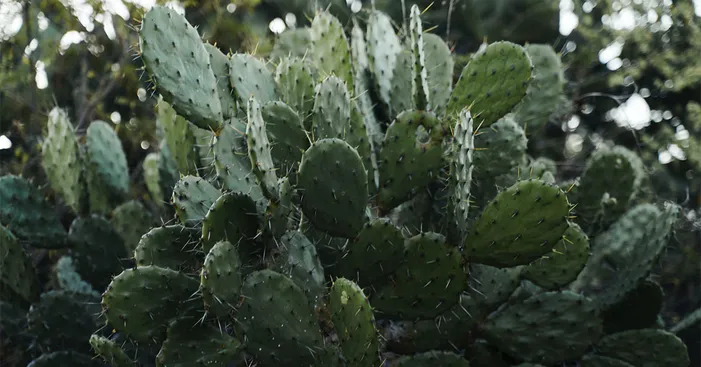
Forget one-size-fits-all!
Nopales, the versatile cactus, presents itself in a delicious buffet of options, each with unique advantages for your health and palate.
Nopales forms in the market:
Powder:
Craving a convenient boost?
Nopales powder shines in smoothies and drinks, effortlessly infusing them with fiber and vitamins.
Tablets:
Prefer a grab-and-go approach?
Nopales tablets and capsules offer a discreet dose of daily wellness.
Juice:
For nature’s purest bounty, indulge in the juicy embrace of a prickly pear.
This vibrant fruit bursts with vitamins and fiber, a tastebud party that nourishes from within.
Fresh paddles:
Don’t discard the paddles! Fresh cladodes, the flat parts of the stem, are edible treats packed with their share of beneficial properties.
Buying tips:
Love the idea of Nopales’s health perks, but unsure where to start.
Let’s navigate the market together!
Organic Advantage:
First things first – go organic!
This means no nasty chemicals, just pure nopales goodness for your body.
Imagine biting into a fresh paddle, knowing it’s naturally clean.
Fresh or Convenient?
Fresh nopales can be tricky, but don’t fret!
Powders and capsules offer hassle-free convenience and controlled doses.
Perfect for on-the-go health warriors!
Ingredients Count:
Check the label like a hawk! Choose 100% pure nopales – say no to fillers or sneaky “excipients”.
Your body deserves the real deal, not bulked-up products.
Gentle Sun-Kiss:
For powders and capsules, low-temperature drying is crucial.
This protects the nopales’s precious vitamins and minerals, like sunshine gently preserving their power.
